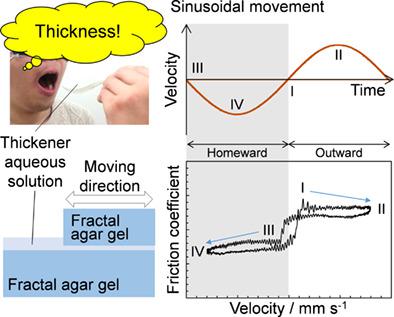当前位置:
X-MOL 学术
›
J. Texture Stud.
›
论文详情
Our official English website, www.x-mol.net, welcomes your feedback! (Note: you will need to create a separate account there.)
Nonlinear friction dynamics in the cognitive process of food textures: Thickness of polysaccharide solution
Journal of Texture Studies ( IF 3.2 ) Pub Date : 2020-06-29 , DOI: 10.1111/jtxs.12538 Hina Okawara 1 , Koki Shinomiya 1 , Minoru Fujita 2 , Tomonori Koda 2 , Akihiro Nishioka 2 , Yoshimune Nonomura 1
Journal of Texture Studies ( IF 3.2 ) Pub Date : 2020-06-29 , DOI: 10.1111/jtxs.12538 Hina Okawara 1 , Koki Shinomiya 1 , Minoru Fujita 2 , Tomonori Koda 2 , Akihiro Nishioka 2 , Yoshimune Nonomura 1
Affiliation

|
"Thickness" is one of the descriptors of texture in liquid and semi-solid foods. In this study, friction in thickener aqueous solutions was evaluated, using a biomimetic friction evaluation system, to show the correlation between friction data and sensory thickness and the recognition mechanism of this sensation during the process of eating. This system can measure friction forces under sinusoidal movement on fractal agar gel, which mimics the morphology and physical properties of the tongue. We found that an increase in the viscosity of the thickener aqueous solution was responsible for both the sensory score of thickness and the asymmetric profile of the friction coefficient in a reciprocating motion. In the case of low viscosity liquids such as water, many of the subjects did not feel thickness, and the friction profile "stable pattern I", that is, a static friction coefficient larger than kinetic friction and a similar profile in the outward and inward processes were observed. However, in the case of solutions containing 3 or 5 wt % of food thickener, the friction profile "unstable pattern I", that is, different friction behaviors in the outward and inward processes, was observed, and many of the subjects experienced strong thickness. In addition, the static friction coefficient at the first cycle was small, and the changes of friction coefficient by the reciprocating motion being repeated was large. These friction phenomena can occur in the mouth and are expected to induce sensory thickness. This article is protected by copyright. All rights reserved.
中文翻译:

食物质地认知过程中的非线性摩擦动力学:多糖溶液的厚度
“厚度”是液体和半固体食物质地的描述词之一。本研究使用仿生摩擦评估系统评估增稠剂水溶液中的摩擦,以显示摩擦数据与感官厚度之间的相关性以及进食过程中这种感觉的识别机制。该系统可以测量分形琼脂凝胶上正弦运动下的摩擦力,模拟舌头的形态和物理特性。我们发现增稠剂水溶液的粘度增加是厚度的感官评分和往复运动中摩擦系数的不对称分布的原因。在水等低粘度液体的情况下,很多受试者感觉不到厚度,摩擦剖面“ 观察到静摩擦系数大于动摩擦并且在向外和向内过程中观察到类似的分布。然而,在含有 3 或 5 重量%食品增稠剂的溶液的情况下,观察到摩擦分布“不稳定模式 I”,即向外和向内过程中的不同摩擦行为,并且许多受试者经历了强烈的稠度. 此外,第一次循环的静摩擦系数小,重复往复运动引起的摩擦系数变化大。这些摩擦现象可能发生在口腔中,预计会引起感觉厚度。本文受版权保护。版权所有。观察到静摩擦系数大于动摩擦并且在向外和向内过程中观察到类似的分布。然而,在含有 3 或 5 重量%食品增稠剂的溶液的情况下,观察到摩擦分布“不稳定模式 I”,即向外和向内过程中的不同摩擦行为,并且许多受试者经历了强烈的稠度. 此外,第一次循环的静摩擦系数小,重复往复运动引起的摩擦系数变化大。这些摩擦现象可能发生在口腔中,预计会引起感觉厚度。本文受版权保护。版权所有。在含有 3 或 5 重量%食品增稠剂的溶液的情况下,观察到摩擦分布“不稳定模式 I”,即向外和向内过程中的不同摩擦行为,并且许多受试者经历了强烈的增稠。此外,第一次循环的静摩擦系数小,重复往复运动引起的摩擦系数变化大。这些摩擦现象可能发生在口腔中,预计会引起感觉厚度。本文受版权保护。版权所有。在含有 3 或 5 重量%食品增稠剂的溶液的情况下,观察到摩擦分布“不稳定模式 I”,即向外和向内过程中的不同摩擦行为,并且许多受试者经历了强烈的增稠。此外,第一次循环的静摩擦系数小,重复往复运动引起的摩擦系数变化大。这些摩擦现象可能发生在口腔中,预计会引起感觉厚度。本文受版权保护。版权所有。第一次循环静摩擦系数小,重复往复运动摩擦系数变化大。这些摩擦现象可能发生在口腔中,预计会引起感觉厚度。本文受版权保护。版权所有。第一次循环静摩擦系数小,重复往复运动摩擦系数变化大。这些摩擦现象可能发生在口腔中,预计会引起感觉厚度。本文受版权保护。版权所有。
更新日期:2020-06-29
中文翻译:

食物质地认知过程中的非线性摩擦动力学:多糖溶液的厚度
“厚度”是液体和半固体食物质地的描述词之一。本研究使用仿生摩擦评估系统评估增稠剂水溶液中的摩擦,以显示摩擦数据与感官厚度之间的相关性以及进食过程中这种感觉的识别机制。该系统可以测量分形琼脂凝胶上正弦运动下的摩擦力,模拟舌头的形态和物理特性。我们发现增稠剂水溶液的粘度增加是厚度的感官评分和往复运动中摩擦系数的不对称分布的原因。在水等低粘度液体的情况下,很多受试者感觉不到厚度,摩擦剖面“ 观察到静摩擦系数大于动摩擦并且在向外和向内过程中观察到类似的分布。然而,在含有 3 或 5 重量%食品增稠剂的溶液的情况下,观察到摩擦分布“不稳定模式 I”,即向外和向内过程中的不同摩擦行为,并且许多受试者经历了强烈的稠度. 此外,第一次循环的静摩擦系数小,重复往复运动引起的摩擦系数变化大。这些摩擦现象可能发生在口腔中,预计会引起感觉厚度。本文受版权保护。版权所有。观察到静摩擦系数大于动摩擦并且在向外和向内过程中观察到类似的分布。然而,在含有 3 或 5 重量%食品增稠剂的溶液的情况下,观察到摩擦分布“不稳定模式 I”,即向外和向内过程中的不同摩擦行为,并且许多受试者经历了强烈的稠度. 此外,第一次循环的静摩擦系数小,重复往复运动引起的摩擦系数变化大。这些摩擦现象可能发生在口腔中,预计会引起感觉厚度。本文受版权保护。版权所有。在含有 3 或 5 重量%食品增稠剂的溶液的情况下,观察到摩擦分布“不稳定模式 I”,即向外和向内过程中的不同摩擦行为,并且许多受试者经历了强烈的增稠。此外,第一次循环的静摩擦系数小,重复往复运动引起的摩擦系数变化大。这些摩擦现象可能发生在口腔中,预计会引起感觉厚度。本文受版权保护。版权所有。在含有 3 或 5 重量%食品增稠剂的溶液的情况下,观察到摩擦分布“不稳定模式 I”,即向外和向内过程中的不同摩擦行为,并且许多受试者经历了强烈的增稠。此外,第一次循环的静摩擦系数小,重复往复运动引起的摩擦系数变化大。这些摩擦现象可能发生在口腔中,预计会引起感觉厚度。本文受版权保护。版权所有。第一次循环静摩擦系数小,重复往复运动摩擦系数变化大。这些摩擦现象可能发生在口腔中,预计会引起感觉厚度。本文受版权保护。版权所有。第一次循环静摩擦系数小,重复往复运动摩擦系数变化大。这些摩擦现象可能发生在口腔中,预计会引起感觉厚度。本文受版权保护。版权所有。

























 京公网安备 11010802027423号
京公网安备 11010802027423号